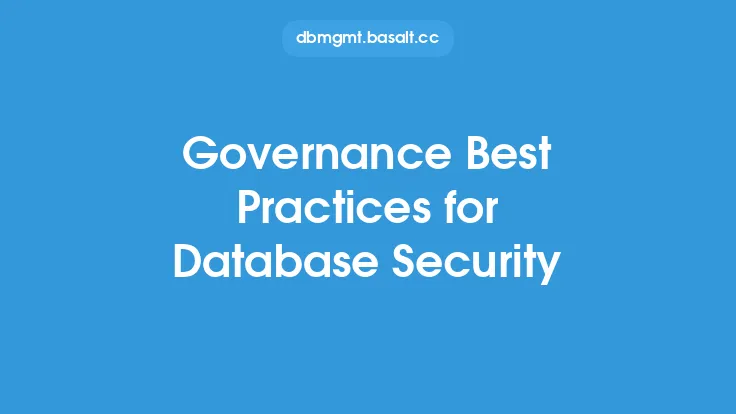Database governance and compliance metrics are essential components of a comprehensive database security strategy. These metrics provide a framework for measuring the effectiveness of an organization's database governance and compliance efforts, ensuring that sensitive data is protected and regulatory requirements are met. In this article, we will delve into the key database governance and compliance metrics, their importance, and how they can be implemented to ensure the security and integrity of an organization's databases.
Introduction to Database Governance Metrics
Database governance metrics are used to measure the performance and effectiveness of an organization's database governance program. These metrics can be categorized into several key areas, including data quality, data security, database performance, and compliance. Data quality metrics, for example, measure the accuracy, completeness, and consistency of data within the database. Data security metrics, on the other hand, measure the effectiveness of access controls, authentication, and authorization mechanisms in preventing unauthorized access to sensitive data. Database performance metrics measure the efficiency and responsiveness of the database, while compliance metrics measure the organization's adherence to regulatory requirements and industry standards.
Key Compliance Metrics
Compliance metrics are used to measure an organization's adherence to regulatory requirements and industry standards. These metrics can be categorized into several key areas, including data protection, access control, auditing and logging, and incident response. Data protection metrics, for example, measure the effectiveness of encryption, masking, and other data protection mechanisms in preventing unauthorized access to sensitive data. Access control metrics measure the effectiveness of access controls, authentication, and authorization mechanisms in preventing unauthorized access to the database. Auditing and logging metrics measure the effectiveness of auditing and logging mechanisms in detecting and responding to security incidents. Incident response metrics measure the effectiveness of an organization's incident response plan in responding to security incidents.
Implementing Database Governance and Compliance Metrics
Implementing database governance and compliance metrics requires a structured approach. The first step is to identify the key metrics that are relevant to the organization's database governance and compliance program. This can be done by conducting a thorough risk assessment and identifying the key areas of risk. The next step is to establish a baseline for each metric, which can be done by collecting data on the current state of the database. The baseline provides a starting point for measuring the effectiveness of the database governance and compliance program. The final step is to establish a process for regularly collecting and analyzing data on each metric, and using the results to identify areas for improvement.
Technical Implementation of Metrics
From a technical perspective, implementing database governance and compliance metrics requires the use of specialized tools and technologies. For example, data quality metrics can be implemented using data quality tools such as data profiling and data validation. Data security metrics can be implemented using security information and event management (SIEM) systems, which provide real-time monitoring and analysis of security-related data. Database performance metrics can be implemented using database performance monitoring tools, which provide real-time monitoring and analysis of database performance. Compliance metrics can be implemented using compliance management tools, which provide a framework for managing and tracking compliance with regulatory requirements and industry standards.
Best Practices for Database Governance and Compliance Metrics
There are several best practices that organizations can follow when implementing database governance and compliance metrics. The first best practice is to establish a clear and well-defined governance program, which provides a framework for managing and tracking database governance and compliance. The next best practice is to identify the key metrics that are relevant to the organization's database governance and compliance program, and establish a baseline for each metric. The final best practice is to regularly collect and analyze data on each metric, and use the results to identify areas for improvement. Additionally, organizations should ensure that their database governance and compliance metrics are aligned with regulatory requirements and industry standards, and that they are regularly reviewed and updated to ensure their continued effectiveness.
Challenges and Limitations of Database Governance and Compliance Metrics
There are several challenges and limitations associated with implementing database governance and compliance metrics. The first challenge is the complexity of the metrics themselves, which can make it difficult to establish a clear and well-defined governance program. The next challenge is the lack of standardization, which can make it difficult to compare metrics across different organizations and industries. The final challenge is the resource intensity of implementing and maintaining database governance and compliance metrics, which can require significant investments of time and money. Additionally, organizations may face challenges in ensuring the accuracy and completeness of the data used to calculate the metrics, as well as ensuring that the metrics are aligned with regulatory requirements and industry standards.
Future of Database Governance and Compliance Metrics
The future of database governance and compliance metrics is likely to be shaped by several key trends and technologies. The first trend is the increasing use of cloud-based databases, which will require new and innovative approaches to database governance and compliance. The next trend is the increasing use of artificial intelligence and machine learning, which will enable organizations to automate and optimize their database governance and compliance programs. The final trend is the increasing importance of data privacy and protection, which will require organizations to implement more robust and effective database governance and compliance programs. Additionally, the use of emerging technologies such as blockchain and the Internet of Things (IoT) will require organizations to adapt their database governance and compliance programs to ensure the security and integrity of their data.





